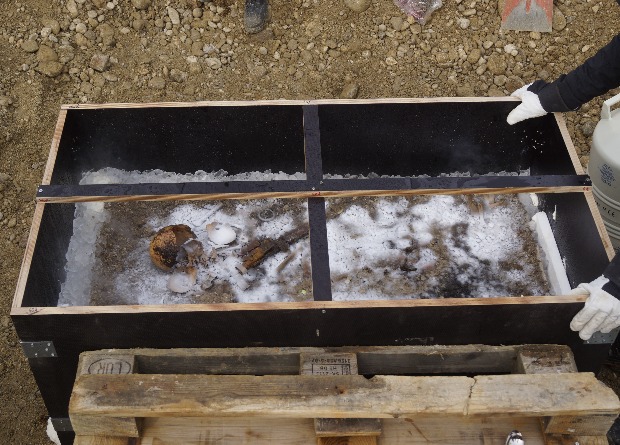German archaeologists discovered in Bavaria a rich burial of a boy of the 7th century AD, at whose feet lay the remains of a dog. Inside the tomb were perfectly preserved gold and silver jewelry, a sword, the remains of leather and fabric products. To safely deliver the finds to the laboratory, the scientists had to freeze the contents of the chamber with liquid nitrogen. The results of the work are reported in a press release from the Office for the Protection of Monuments of Bavaria.
After the fall of the Western Roman Empire in AD 476, the Bavar tribe began to form in and around southern Germany. Presumably, it was formed from the remnants of the Celts, local Romans, part of the Frankish and Alemannic population and other Germans. Although the first mention of the Bavars by the Gothic historian Jordan dates back only to 551, around 555 they organized a tribal duchy dependent on the Franks. In the 7th-8th centuries, the Bavars adopted Christianity, which led to a change in funeral traditions. People were increasingly buried without equipment, and burial complexes became smaller.
Field conservation takes an important place in the work of archaeologists. It is a series of temporary measures aimed at preserving the integrity of the finds immediately after their discovery. This can include clearing in the excavation site, fortifying material, removing artifacts from the ground, or packaging. In some cases, it is necessary to transport entire burials if time or weather does not allow for proper work on site.
Archaeologists from the Office for the Protection of Monuments of Bavaria have discovered in the Mattzis area a well-preserved children’s grave from the 7th century AD. It contained the remains of a boy from a wealthy family, as indicated by the grave goods – a sword and a belt with gold ornaments. Densely made stone walls and ceilings practically did not let precipitation into the chamber. This allowed the finds to be preserved very well, including the remains of cloth and leather – from a scabbard, a weapon belt, clothing and, possibly, a shroud.
Scientists noted that often in the early Middle Ages, objects with Christian symbols are present in burials. Thus, gold leaf crosses were found in the child’s grave. In addition, the burial chamber contained silver bracelets, spurs, and a bronze bowl. The remains of a dog lay at the boy’s feet. It is too early to talk about the child’s age, according to archaeologists. However, milk teeth suggested that he was no more than 10 years old.
Mathias Pfeil, chief conservator of the Bavarian Monuments Office, noted that not many scraps of medieval fabric have survived today. New finds, he said, will allow a new look at the fashion world of that era.
However, retrieving the grave and transporting it to the laboratory proved to be problems for the scientists. There were no stabilizing deposits inside it, so it could easily get damaged on the road. The researchers resorted to shock freezing – they wetted the contents of the chamber with water layer by layer and froze it with liquid nitrogen at a temperature of -196 degrees Celsius. The procedure lasted 14 hours, after which the burial was removed with a crane and delivered for restoration work to the laboratory in the city of Bamberg.









